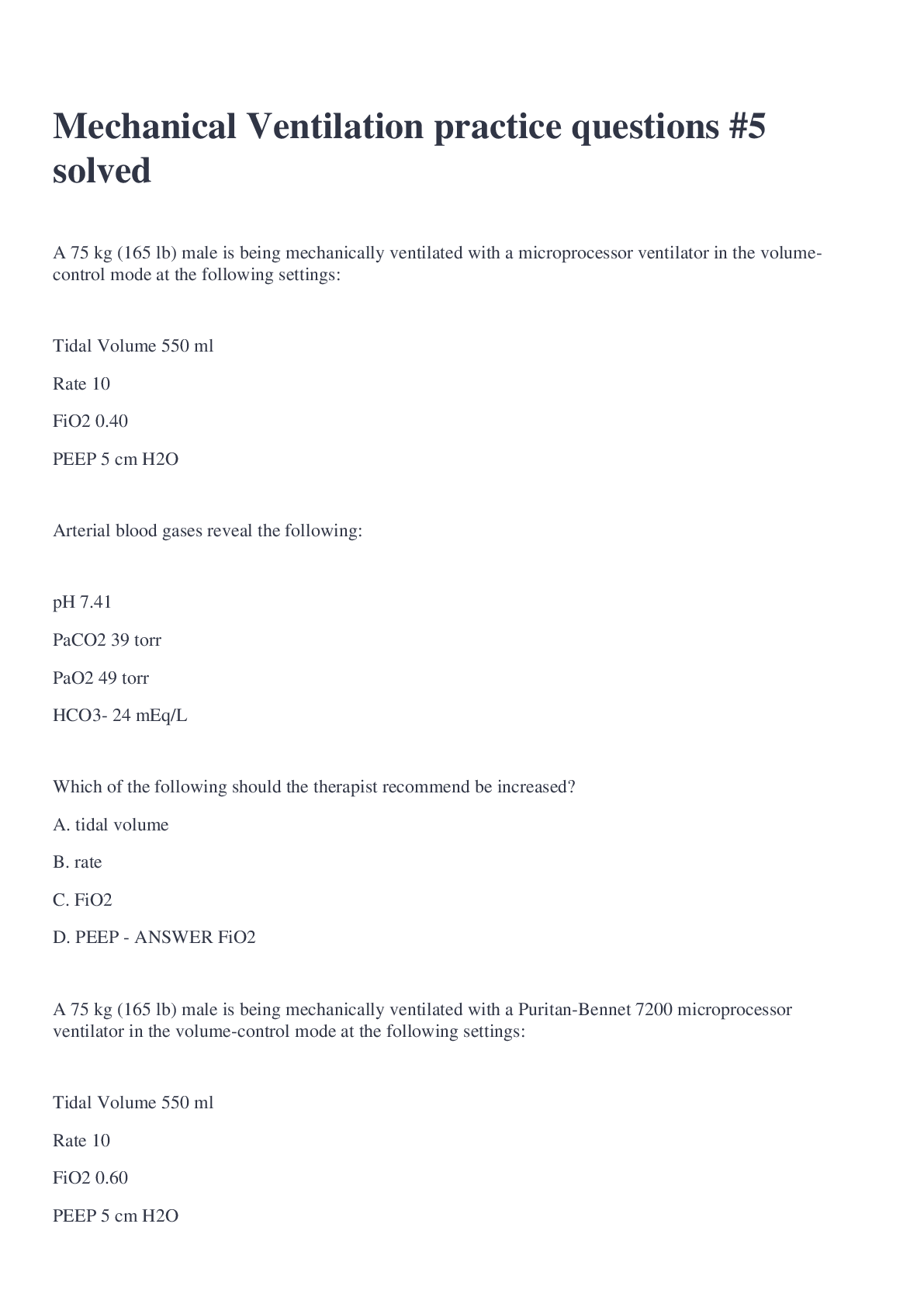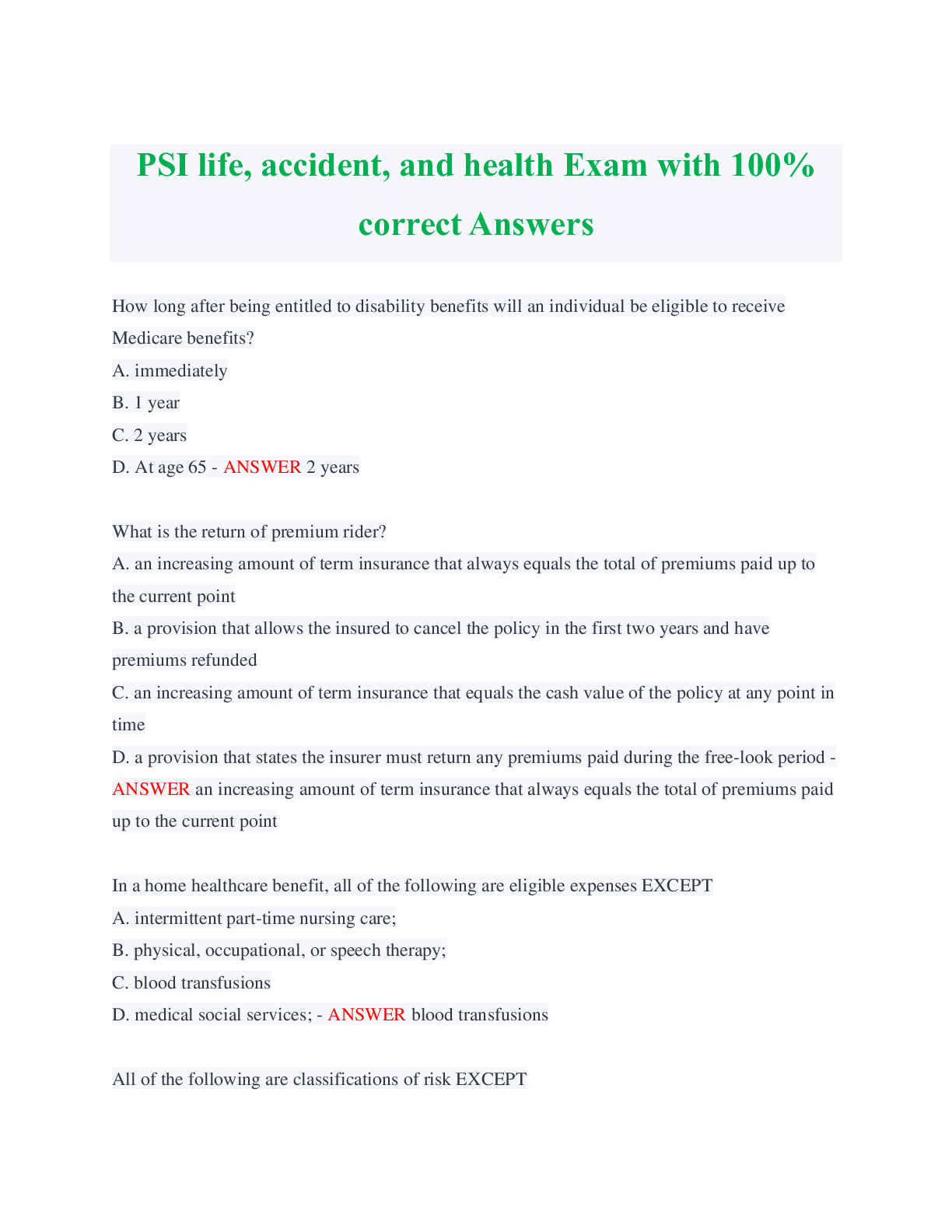Mechanical Ventilation practice questions #5 solved
Document Content and Description Below
A 75 kg (165 lb) male is being mechanically ventilated with a microprocessor ventilator in the volume-control mode at the following settings: Tidal Volume 550 ml Rate 10 FiO2 0.40 PEEP 5 cm ... H2O Arterial blood gases reveal the following: pH 7.41 PaCO2 39 torr PaO2 49 torr HCO3- 24 mEq/L Which of the following should the therapist recommend be increased? A. tidal volume B. rate C. FiO2 D. PEEP - ANSWER FiO2 A 75 kg (165 lb) male is being mechanically ventilated with a Puritan-Bennet 7200 microprocessor ventilator in the volume-control mode at the following settings: Tidal Volume 550 ml Rate 10 FiO2 0.60 PEEP 5 cm H2O Arterial blood gases reveal the following: pH 7.41 PaCO2 39 torr PaO2 49 torr HCO3- 24 mEq/L Which of the following should the therapist recommend be increased? - ANSWER PEEP A 75 kg (165 lb) male is being mechanically ventilated with a Hamilton Amadeus microprocessor ventilator in the volume-control mode at the following settings: Tidal Volume 700 ml Rate 10 FiO2 0.40 PEEP 5 cm H2O Arterial blood gases reveal the following: pH 7.31 PaCO2 49 torr PaO2 89 torr HCO3- 22 mEq/L Which of the following should the therapist recommend be increased? A. tidal volume B. rate C. FiO2 D. PEEP - ANSWER tidal volume A 75 kg (165 lb) male is being mechanically ventilated with a microprocessor ventilator in the volume-control mode at the following settings: Tidal Volume 700 ml Rate 10 FiO2 0.40 PEEP 5 cm H2O PIP 21 cm H2O Arterial blood gases reveal the following: pH 7.31 PaCO2 49 torr PaO2 68 torr HCO3- 22 mEq/L Which of the following should the therapist recommend be increased? A. tidal volume B. rate C. FiO2 D. PEEP - ANSWER tidal volume A 75 kg (165 lb) male is being mechanically ventilated with a Servo 300 microprocessor ventilator in the volume-control mode at the following settings: Tidal Volume 900 ml Rate 8 FiO2 0.35 PEEP 4 cm H2O Arterial blood gases reveal the following: pH 7.31 PaCO2 49 torr PaO2 89 torr HCO3- 22 mEq/L Which of the following should the therapist recommend be increased? A. tidal volume B. rate C. FiO2 D. PEEP - ANSWER rate A 75 kg (165 lb) male is being mechanically ventilated with a Newport Breeze microprocessor ventilator in volume-control mode at the following settings. The following patient information is available. Tidal Volume 550 ml Rate 10 FiO2 0.60 PEEP 30 cm H2O Static Compliance 60 ml/cm H2O pH 7.37 PaCO2 44 torr PaO2 49 torr HCO3- 22 mEq/L Qt 6.6 L/min The therapist should now recommend: A. Decrease PEEP B. Decrease FiO2 C. Increase tidal volume D. Increase PEEP - ANSWER Increase PEEP A 75 kg (165 lb) male is being mechanically ventilated with a Hamilton Amadeus microprocessor ventilator in volume-control mode at the following settings. The following patient information is available. Tidal Volume 750 ml Rate 10 FiO2 0.40 PEEP 8 cm H2O pH 7.39 PaCO2 42 torr PaO2 91 torr HCO3- 23 mEq/L Cardiac Index 1.2 L/min/m2 The therapist should now recommend: A. Decrease PEEP B. Decrease FiO2 C. Maintain current settings D. Increase PEEP - ANSWER Decrease PEEP An 18 year-old 50 kg (110 lb) female is being mechanically ventilated with a Hamilton Veolar microprocessor ventilator in the pressure-control mode and a heat-moisture exchanger attached with a fifteen inch flex hose. Ventilator settings and arterial blood gases are as follows: PIP 25 cm H2O Rate 10 FiO2 0.40 Exhaled Tidal 600 ml Volume PEEP 3 cm H2O pH 7.33 PaCO2 47 torr PaO2 93 torr HCO3- 22 mEq/L The therapist should now recommend: A. increase the PIP B. decrease the deadspace C. increase the rate D. decrease the tidal volume - ANSWER decrease the deadspace A 66 kg (145 lb) female is being mechanically ventilated with a Hamilton Veolar microprocessor ventilator in the pressure-control mode. Ventilator settings and arterial blood gases are as follows: PIP 20 cm H2O Rate 10 FiO2 0.40 Exhaled Tidal Volume 450 ml PEEP 3 cm H2O pH 7.33 PaCO2 49 torr PaO2 68 torr HCO3- 22 mEq/L The therapist should now recommend: A. increase the PIP B. decrease the FiO2 C. increase the rate D. decrease the tidal volume - ANSWER increase the PIP A 70 kg (154 lb) male is recieving non-invasive positive pressure ventilation (NIPPV) with a BiPAP ventilator set to 15 / 5. Arterial blood gases are as follows: pH 7.33 PaCO2 49 torr PaO2 83 torr Which of the following IPAP / EPAP settings would best improve the patient's condition. A. 10 / 2 B. 15 / 10 C. 20 / 10 D. 20 / 5 - ANSWER 20 / 5 A 75 kg (165 lb) male is being mechanically ventilated with a microprocessor ventilator in volume-control mode at the following settings. The following patient information is available. Mode SIMV Mandatory Rate 8 Total Rate 32 Tidal Volume 750 ml PIP 35 cm H2O Exhaled minute volume 7.2 L FiO2 0.45 PEEP 8 cm H2O pH 7.48 PaCO2 31 torr PaO2 89 torr HCO3- 22 mEq/L The therapist should now recommend: A. Decrease PEEP B. Increase mandatory rate to 12 C. Add pressure support D. Initiate pressure control mode - ANSWER Add pressure support A 80kg (176 lb) male suffering from acute respiratory distress syndrome (ARDS) is being mechanically ventilated with a Servo 300A microprocessor ventilator in volume-control mode at the following settings. The following patient information is available. Mode Assist/control Tidal Volume 650 ml Mandatory Rate 10 Total Rate 10 PIP 68 cm H2O FiO2 0.45 PEEP 8 cm H2O pH 7.37 PaCO2 44 torr PaO2 89 torr HCO3- 22 mEq/L The therapist should now recommend: A. Decrease PEEP B. Switch to SIMV mode C. Add pressure support D. Initiate pressure control mode - ANSWER Initiate pressure control mode A premature neonate with respiratory distress syndrome is being mechanically ventilated with a pressure-limited, time-cycled ventilator at the following settings: PIP 25 cm H2O Rate 24/min Flow 7 L/min I time 0.6 sec. FIO2 0.45 PEEP 4 cm H2O Arterial blood gas results from an umbillical artery line are as follows: pH 7.29 PaCO2 62 torr PaO2 68 torr HCO3- 22 mEq/L The therapist should now recommend: A. Increase PEEP B. Increase the I time C. Increase the rate D. Decrease PIP - ANSWER Increase the rate A premature neonate with respiratory distress syndrome is being mechanically ventilated with a pressure-limited, time-cycled ventilator at the following settings: PIP 25 cm H2O Rate 28/min Flow 7 L/min I time 0.5 sec. FIO2 0.70 PEEP 4 cm H2O Arterial blood gas results from an umbillical artery line are as follows: pH 7.30 PaCO2 59 torr PaO2 66 torr HCO3- 22 mEq/L The therapist should now recommend: A. Increase PEEP B. Increase the I time C. Decrease the rate D. Decrease PIP - ANSWER Increase the I time A 33 week gestation neonate with respiratory distress syndrome is being mechanically ventilated with a high frequency ocillator ventilator at the following settings: PIP 20 cm H2O Frequency 12 Hz I time 30% FIO2 0.55 PEEP 4 cm H2O Arterial blood gas results from an umbillical artery line are as follows: pH 7.31 PaCO2 52 torr PaO2 66 torr HCO3- 21 mEq/L The therapist should now recommend: A. Increase PEEP B. Increase the I time C. Decrease the Frequency D. Increase the Amplitude - ANSWER Increase the Amplitude [Show More]
Last updated: 2 years ago
Preview 1 out of 10 pages

Buy this document to get the full access instantly
Instant Download Access after purchase
Buy NowInstant download
We Accept:

Reviews( 0 )
$7.00
Can't find what you want? Try our AI powered Search
Document information
Connected school, study & course
About the document
Uploaded On
Oct 02, 2022
Number of pages
10
Written in
Additional information
This document has been written for:
Uploaded
Oct 02, 2022
Downloads
0
Views
67















